Hyundai Sonatas had always been pleasantly styled cars. They just weren't in any way memorable. Then the redesigned 2011 arrived, and grabbed the attention of even people who rarely notice cars. Segment-leading fuel economy and base-engine horsepower didn't hurt, either. Hyundai followed up with similar redesigns for its other cars, and dealers have had trouble keeping them in stock.
But competitors have since responded with their own redesigned midsize sedans. Compared to new entrants from Mazda and Nissan, how does the now mid-cycle (but not yet enhanced) Sonata hold up?
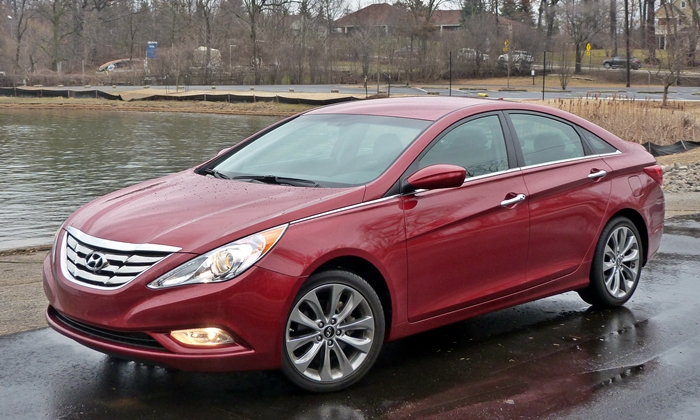
Dramatic styling includes a steeply raked windshield. more Sonata photos
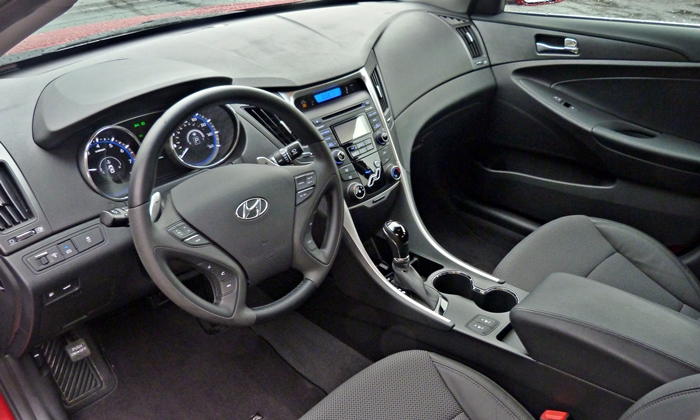
Attractive curves cut into actual and especially perceived roominess. Dark in the SE.
| |
Compared to the Mazda6 |
| Warranty, maintenance cost |
 Better
Worse
Better
Worse
|
I intended to compare the Sonata primarily to the Nissan Altima. But I tested a sport-tuned SE, and Nissan doesn't offer a similar variant of its four-cylinder midsize sedan. (A Sonata GLS or Limited would be more comparable.) So I'm primarily comparing the Sonata SE to the driver-oriented Mazda6, while also noting how it compares to the Altima. This forces a reshuffle of the pros and cons, as Sonata's strengths and weaknesses more closely match the Mazda's than the Nissan's. Most notably, the Sonata SE is more stylish and more fun-to-drive than the Altima, but at best matches the Mazda6 in these areas.
This moves Hyundai's longer warranty to the top spot on the "why to buy" list. The others provide 3 year, 36,000 basic coverage and a 5/60 powertrain warranty. Hyundai provides 5/60 basic coverage and a 10/100 powertrain warranty (5/60 for second owners).
Not that you'll likely make frequent use of the warranty. In TrueDelta's car reliability survey the 2011 Sonata has been about average, while the 2012 and 2013 have required few repairs.
| Price or payments |
 Better
Worse
Better
Worse
|
Hyundais aren't as cheap as they used to be, and with dealers selling all they can get discounts aren't often large. A 2013 Hyundai Sonata SE lists for $24,120, $1,125 less than a 2014 Mazda6 Touring. Adjust for the Hyundai's additional standard equipment (including, but not limited to, partial leather upholstery, proximity key, heated front seats, Bluelink telematics system) and its advantage widens to about $2,300. A Hyundai Sonata GLS with Popular Equipment Package similarly undercuts a 2013 Nissan Altima SV by $2,385 before adjusting for feature differences, and by a few hundred more afterwards.
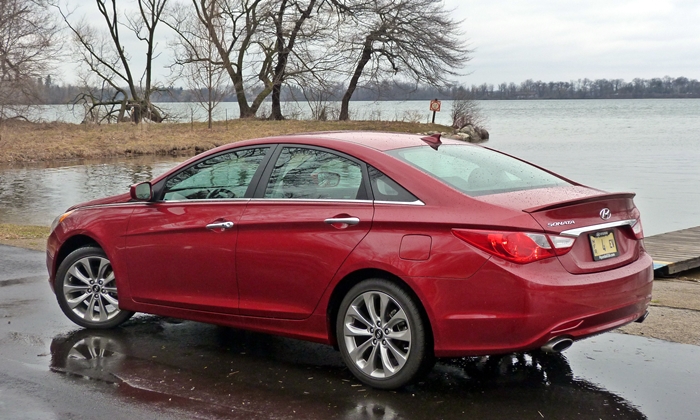
Coupe-like roofline. Tail light assemblies also wrap well around the Sonata's corners.
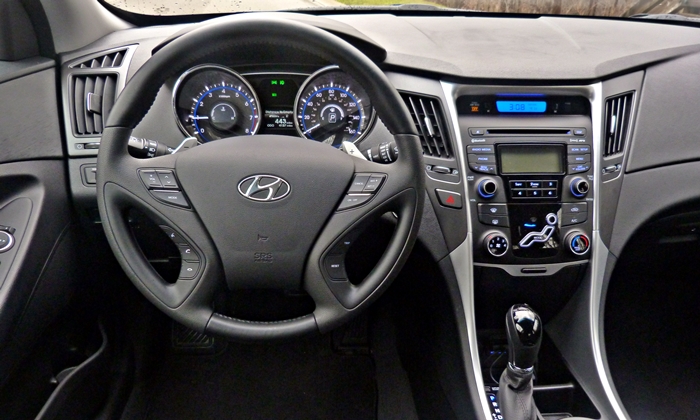
Logically organized controls include four knobs. Warm blue highlights. Poorly trimmed wheel.
| Powertrain performance |
 Better
Worse
Better
Worse
|
I was scheduled to test a 2013 Hyundai Sonata SE 2.0T, with a 274-horsepower turbocharged engine. I'm somewhat embarrassed to admit that for the first two days I drove this red Sonata I didn't realize that it wasn't the turbo. Granted, it didn't feel as effortlessly powerful as the related Kia Optima SXL I reviewed recently. But it was still plenty quick for my regular suburban driving, suggesting that few people often would take advantage of the turbo's additional thrust. Credit a still segment-leading 200-horsepower 2.4-liter four-cylinder engine (to get more power in a midsize sedan you need either two more cylinders or a turbo) and a six-speed automatic transmission so responsive that the provided paddles saw little use.
Owing to the trickery of its CVT, the Nissan Altima is about as quick (but feels and sounds much less pleasant when skedaddling). Plant your foot and the Mazda6 will also get to sixty in a bit under eight seconds, and make the most thrilling noises in the process. But in typical driving the Mazda feels less energetic due to a combination of a more relaxed throttle calibration and a transmission that upshifts more readily.
| Exterior styling |
 Better
Worse
Better
Worse
|
The 2013 Hyundai Sonata's exterior might not induce double-takes the way it did two years ago, but when outfitted with the SE's 18-inch rims it's still one of the most striking cars in the segment. I personally prefer the less swoopy but more sportily proportioned Mazda6, but can see how some people will prefer the looks of the Hyundai. So I'll call this one a draw. Either car is more attractive than the relatively plain Altima.
| Rear seat room & comfort |
 Better
Worse
Better
Worse
|
According to the EPA's classification system, the Hyundai Sonata is actually a large car. You wouldn't guess this while sitting in the front seat. A steeply raked windshield and cockpit-like instrument panel design cut into actual roominess, and perceived roominess even more. The Sonata's firm front buckets could use more form-fitting contouring. Though not uncomfortable, they are the least comfortable buckets in this threesome.
In the back seat, six-foot passengers' scalps might graze the headliner, but knee room is generous. There's a bit more room and a more comfortably padded and positioned rear seat cushion inside the Altima. But the Mazda6's rear seat is at least as low to the floor as the Sonata's and includes a couple inches less knee room. So the Hyundai has a slight edge over the Mazda.
| |
Compared to the Mazda6 |
| Quietness |
 Better
Worse
Better
Worse
|
Prior to this test, I didn't recall the Hyundai Sonata as a noisy car, and it still isn't. There's a bit more road noise inside the Mazda. But other competitors, including the Altima, Fusion, and especially the Malibu, are now significantly quieter inside, and seem more upscale partly as a result.
| Handling |
 Better
Worse
Better
Worse
|
The 2013 Hyundai Sonata SE's suspension is 20 percent stiffer than those in the GLS and Limited. Consequently, it rolls less in turns and generally feels a little more athletic, but it also soaks up bumps less well. The suspension in the Mazda6 better controls body motions, to the benefit of both ride and handling. The Sonata's electric motor-assisted power steering, while quick (even too quick at highway speeds) continues to feel more artificial and to provide less nuanced feedback than that in the Mazda6. So, while the Sonata SE is more a driver's car than the softer, much less grippy Altima, it's not as engaging or as satisfying as the Mazda6.
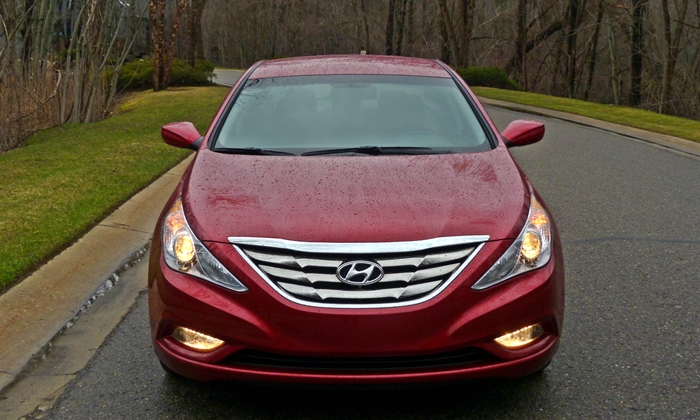
Large chrome grille and headlamp assemblies that extend well into the fenders.
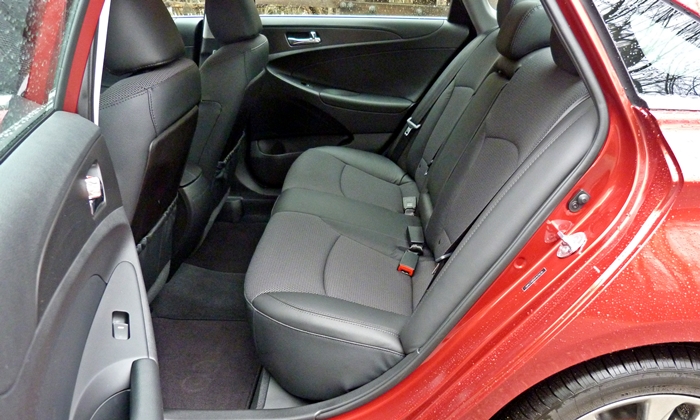
Plenty of legroom, but low cushion to permit decent headroom beneath fast roof line.
| Driving position & visibility |
 Better
Worse
Better
Worse
|
A steeply raked windshield dominates the view forward from the 2013 Hyundai Sonata's driver seat. The instrument panel isn't overly tall or deep, so forward visibility is nevertheless pretty good. But owing to a more upright windshield and a more compact instrument panel the driving position in the Altima is better and that in the Mazda6 is nearly ideal. Rearward visibility is limited by the Sonata's high tail and fashionably fast rear pillars, but the same can be said of most current midsize sedans.
| Materials & workmanship |
 Better
Worse
Better
Worse
|
Two years ago the Hyundai Sonata's interior materials were above the segment average. Here too, though, some competitors (if not the Altima and Mazda6) have been leaping ahead. The Limited's interior is a little nicer, especially in warmer tan. The 2013 SE's largely black interior, with unexceptional cloth on the center panels of the seats, seems drab in comparison. Bright-colored stitching would help. A steering wheel upgrade is needed most of all. The current wheel is only partially wrapped in leather, and the leather sections are very slippery. Such leather used to be the norm on the steering wheels of up-level Korean cars, but they've been learning that the point of leather is to enhance the driver's grip. It's time for that learning to make it's way into the Sonata.
| Fuel economy |
 Better
Worse
Better
Worse
|
In fuel economy as well the 2013 Hyundai Sonata has lost an earlier lead. EPA ratings of 24 mpg city, 35 highway, impressive two years ago, can't match the 2014 Mazda6's 26/38 or the 2013 Altima's 27/38 today. The trip computer reported about 25 in my regular suburban driving, a bit over 30 if I engaged in some mild hypermiling, and about 34 on the highway. When mildly hypermiling the Altima for a few miles its trip computer average approached 40. While trip computers aren't always accurate, others have also reported impressive fuel economy from the Altima. The Mazda has a smaller edge, but an edge nonetheless.
In its third model year, the current Hyundai Sonata SE remains among the best-looking midsize sedans. But its now average-at-best quietness, interior materials, and fuel economy betray its age. Car buyers whose top priority is handling or a quiet, comfortable ride will likely prefer the Mazda6 or Altima, respectively. But the 2013 Sonata no doubt will continue to win many buyers whose priorities give greater weight to its long warranty, relatively low price, and strong powertrain. Or who simply prefer how it looks.
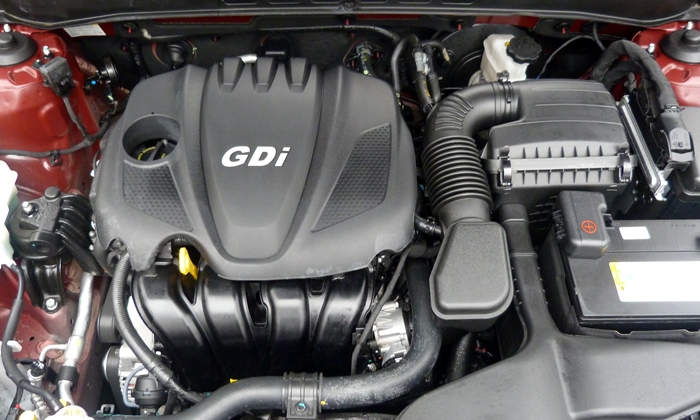
200-horsepower 2.4-liter four-cylinder engine. For more power, you need more cylinders or a turbo.
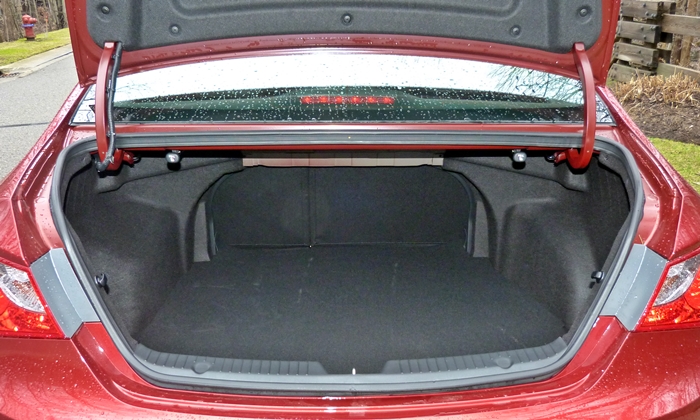
Large, 16.4 cubic foot trunk. The Mazda6's is 16.6, the Altima's 15.4.
See more 2013 Hyundai Sonata photos
Hyundai provided an insured car for a week with a tank of gas. Comparison cars were provided by Brian Evans of Suburban Nissan (248-715-2062) and by Damon Vasoughi of Suburban Mazda (248-741-7803).











